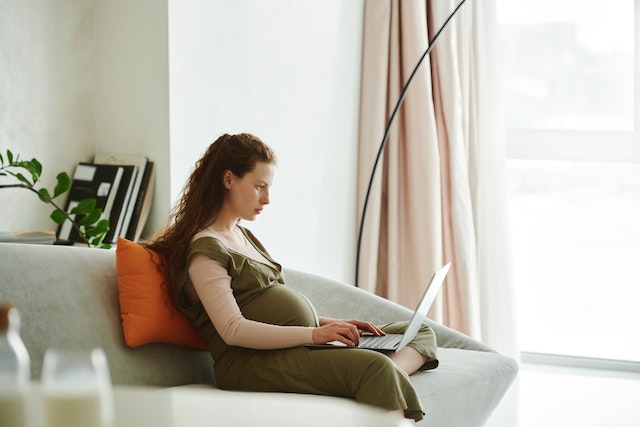 If you are pregnant and working in the UK, you may be wondering how long your maternity leave will be. The good news is that UK law entitles most pregnant employees to a minimum of 52 weeks of maternity leave. This leave can be taken all at once, or split into several periods, as long as the total amount does not exceed 52 weeks. In this blog post, we will discuss the length of maternity leave, how to take maternity leave in the UK, the benefits often associated with this time away from work, and what rights you have as an employee.
If you are pregnant and working in the UK, you may be wondering how long your maternity leave will be. The good news is that UK law entitles most pregnant employees to a minimum of 52 weeks of maternity leave. This leave can be taken all at once, or split into several periods, as long as the total amount does not exceed 52 weeks. In this blog post, we will discuss the length of maternity leave, how to take maternity leave in the UK, the benefits often associated with this time away from work, and what rights you have as an employee.
Length of Maternity Leave in the UK
In the United Kingdom, new mothers are entitled to up to 52 weeks of maternity leave. The first 26 weeks are considered to be ‘Ordinary Maternity Leave’, and the remaining time is known as ‘Additional Maternity Leave’. The UK’s maternity leave policies are among the most generous in Europe, providing new mothers with a significant amount of time to bond with their baby and recover from childbirth.
Couples who are adopting a child are also entitled to leave, with one person in the couple able to take 26 weeks of ‘Ordinary Adoption Leave’ and 26 weeks of ‘Additional Adoption Leave’. This leave can start 14 days before the child begins to live with the individual, when the child arrives in the country (for overseas adoptions), or the day the baby is born (for couples using the aid of a surrogate). The person who isn’t taking Statutory Adoption Leave is instead eligible for paternity leave.
Statutory Maternity Pay
During maternity leave, women receive what is known as Statutory Maternity Pay (SMP), which is paid for by the government for up to 39 weeks. This 39-week period includes time taken prior to the birth of the child. For example, a woman who opts to start her leave one month before the birth of her child would receive 35 weeks of Statutory Maternity Pay after delivery. The first six weeks of SMP see employees receiving 90% of their average weekly earnings before tax, with the following 33 weeks involving payments of £156.66 per week. Women earning less than £156.66 per week will continue to receive 90% of their average weekly earnings before tax. It’s also important to note that you get the same maternity leave and pay if you are having more than one child.
Statutory Adoption Pay is also available for couples looking to adopt a child, the weekly payment amounts are the same as SMP.
How to take Maternity Leave in the UK
Employees taking maternity leave are encouraged to inform their employer about their pregnancy when they feel comfortable to do so. In order to receive Statutory Maternity Pay, you will need to provide your employer with written confirmation from a midwife or doctor at least 15 weeks prior to your due date. You will also need to give your employer 28 days notice as to when you would like to start your leave, however, obvious exceptions are made for rare circumstances.
Women who aren’t able to access Statutory Maternity Pay may instead be eligible to claim Maternity Allowance, which provides up to £156.66 per week for 39 weeks. The exact amount that each individual receives will depend on whether they’re self-employed, have recently stopped working, or if their regular employer is refusing to pay SMP.
What you need to confirm your pregnancy to your employer
Maternity certificate, also known as form MATB1, given by a doctor or midwife. This is typically provided after a 20-week scan.
OR
Written letter from your midwife or doctor informing your employer of your pregnancy.
When Does Maternity Leave Start?
The earliest you can take maternity leave in the UK is 11 weeks before your baby is due. A start date is typically agreed on between the employee and employer, however, leave can start prior to the agreed date in the case of an early birth or pregnancy-related illness.
If you are having a multiple birth, you may be entitled to take leave earlier. You will need to give your employer eight weeks’ notice if you want to take advantage of this. If you are unable to give this much notice, you should still speak to your employer as soon as possible. They may be able to offer you some flexibility.
Maternity leave can be a wonderful time to bond with your new baby and spend time with family. It can also be a challenging time, so it is important to plan ahead and make sure you have the support you need.

How to Prepare for Maternity Leave
Before you start planning for long sleepless nights and dirty diapers, there’s one more important task at hand: preparing for your maternity leave. While it may seem like there’s a lot to do, a little planning can go a long way in making the transition to parenthood a smooth one.
First, talk to your employer about your leave plans. It’s important to give your workplace as much notice as possible, allowing them to organise for someone to take over your role whilst you are on maternity leave. If possible, tell your employer about the expected week of the child’s birth, ensuring that any correspondence is recorded to limit potential unfair treatment down the line. If you’re not sure what your rights are, the Gov.uk website can be a helpful resource.
Next, start getting your finances in order. If you’re not currently saving for a rainy day, now is the time to start. Begin by setting up a budget and looking for ways to cut back on non-essential expenses. Maternity leave can be expensive, so it’s also a good idea to start looking into Statutory Maternity Leave, Maternity Allowance, or Contractual Maternity Pay that your employer might provide.
Finally, take some time to think about your childcare options. If you’re planning on quickly returning to work after your maternity leave, you’ll need to make arrangements for someone to care for your child. This can be a family member, friend, or professional childcare provider. Once you’ve decided on a plan, be sure to communicate your needs and expectations to your employer and chosen caregiver.
Preparing for maternity leave doesn’t have to be stressful. By taking some time to plan ahead, you can focus on enjoying time with your new baby knowing that everything else is taken care of. The UK’s maternity leave entitlement is one of the most generous in Europe, but it can still be a challenge for new mothers to juggle work and family life.
Rights of Pregnant Employees in the UK
Pregnant employees in the UK have a number of legal rights, which are designed to protect their health and wellbeing. For example, pregnant employees are entitled to paid time off for antenatal appointments, and they must be given reasonable adjustments to help them carry out their duties. Additionally, pregnant employees must not be treated less favourably than other employees, and they must not be put at a disadvantage by any workplace policies or practices. If an employer fails to meet these obligations, they may be liable for discrimination. Additionally, pregnant employees who are made redundant have special protections under the law. For example, they must be offered alternative employment if a suitable vacancy is available. These employment rights are designed to ensure that pregnant employees can continue to work without suffering any undue hardship.
Benefits of Maternity Leave
Maternity leave allows mothers to spend time bonding with their child and preparing for their return to work. Additionally, it provides mothers with the opportunity to recover from childbirth and enjoy a well-deserved break.
There are many additional benefits of maternity leave, both for mothers and for businesses. Mothers who take maternity leave are less likely to experience postnatal depression, and they are also more likely to breastfeed for longer. In terms of businesses, supporting employees through maternity leave can help to retain talented workers who might otherwise leave if not given proper support. Additionally, businesses offering generous contractual maternity pay and workplace reintegration initiatives often find themselves as a target for top talent looking to start a family.
 Can You Earn Money While on Maternity Leave in the UK?
Can You Earn Money While on Maternity Leave in the UK?
Generally, if you opt to work for an employer during your maternity leave period, you will be unable to continue to receive maternity payments. However, new mothers are able to work up to 10 ‘Keeping in Touch’ days (KIT days) throughout the course of their maternity leave, without this work impacting any payments they receive. These days would generally be organised with an employer before the start of maternity leave and serve to allow women to remain engaged with their colleagues and aware of relevant workplace changes. Businesses cannot force new mothers to take KIT days, and employees cannot demand that their employer facilitate them.
The rules for self-employed work are drastically different, with women on maternity leave able to work on a self-employed basis without it impacting their Statutory Maternity Pay. Any self-employed work should be genuine, with the individual responsible for paying their own taxes, working on behalf of their own clients or customers, and fully engaging with all aspects of their individual venture. Employees aren’t able to claim self-employment and simply work for their existing employer. In addition, self-employed work undertaken whilst on maternity leave is subject to existing employment contracts, making it vital for employees to discuss any freelance work or individual business ventures with their superiors. It’s important to note that women on Maternity Allowance are unable to work for themselves without it impacting their payments, instead, these people can only work the previously mentioned 10 KIT days.
Returning to Work After Maternity Leave
For some mothers, returning to the workplace after the birth of a child can be a tall task. Various options exist for women looking to return to their former roles, with entitlements differing depending on whether you opt to take 26 weeks or fewer away from your workplace.
Currently, mothers who have been on maternity leave for 26 weeks or fewer are entitled to return to their former roles, under their former pay and conditions. Employers who stop these women from returning to their old roles open themselves up to unfair dismissal claims centred around maternity discrimination.
Mothers who opt to take more than 26 weeks of maternity leave are allowed to be offered different roles, however, these offers can only be made if the old job no longer exists and the new role has equal or better conditions than the one held before maternity leave.
If you return to work before taking your full entitlement, you may be able to take unpaid leave at a later date. You should discuss this with your employer in advance. Mothers who are self-employed or who work part-time may have different entitlements. For more information, it’s important to speak to your employer directly.
Tips for Returning to Work After Maternity Leave
Returning to work after an extended period of leave can be daunting, and it’s important to ease yourself back into the workplace gradually. Here are a few tips to help you make the transition:
- Schedule a few catch-up days before your first day back. This will give you time to catch up on any work that may have accumulated while you were away. As previously mentioned, the UK allows for 10 ‘Keeping in Touch’ days that allow new mothers to check in on their workplace without impacting Statutory Maternity Pay.
- Make sure you’re well-rested and ready to work. If possible, schedule your return for a time when you know you’ll be at your best.
- Avoid over scheduling yourself. It’s tempting to try to make up for lost time by cramming in as much work as possible, but this will only lead to burnout. Instead, focus on quality over quantity.
- Reconnect with your colleagues. Before you start working again, take some time to catch up with your co-workers and get reacquainted with the office dynamic.
- Take some personal time for yourself. Once you’re back in the swing of things, remember to schedule some personal time for yourself outside of work. This will help you maintain a healthy work-life balance.
Maternity leave can be a challenging time for mothers as they try to balance work and family life. However, with a little bit of planning, it is possible to make the transition back to work smoothly. These tips will help you get started!
Did you find this blog post helpful? Do you have any additional questions about maternity leave in the UK? Share your thoughts with us online by reaching out to us on Facebook and Twitter, or call us on 02039709731.
Looking for more articles?
You can visit the links below to find more workplace insights:
10 Common Employee Misconceptions in the Workplace and How to Avoid Them
5 Things That UK Employees Want in an Office Environment
Average Office Worker Salary UK: How Does Your Job Stack Up?
Top Ten Industries in the UK
The Step-by-Step Ultimate Office Move Checklist for 2022

